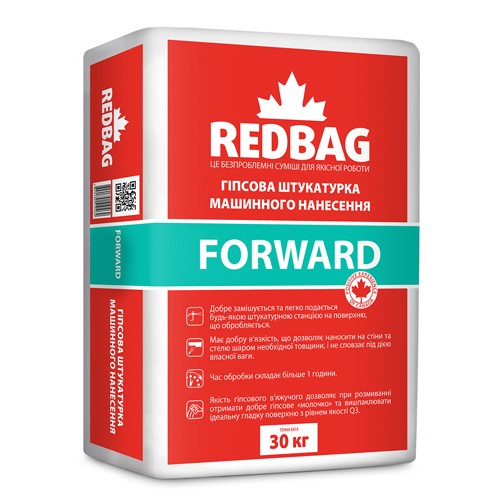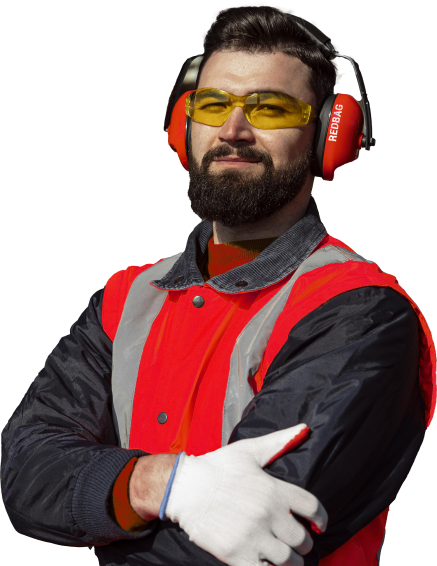REDBAG FORWARD MACHINE-APPLIED GYPSUM PLASTER is a mixture made on the basis of gypsum binder, polymer additives and light perlite filler. It is intended for leveling walls and ceilings with various types of bases mechanically (using mortar mixing applications) for subsequent finishing (painting, wallpapering, etc.) inside buildings with a layer thickness of 6 to 35 mm per application. It is used in rooms with a normal level of air humidity, including kitchens and bathrooms. Maximum filler fraction size: 1.25 mm.

REDBAG FORWARD MACHINE-APPLIED GYPSUM PLASTER
It is well mixed and easily applied by any plastering station to the surface being treated. It has good viscosity, which allows it to be applied to both walls and ceilings with a layer of the required thickness, and does not slip under its own weight. The processing time is more than 1 hour. The quality of the gypsum binder allows you to obtain a good gypsum "milk" when diluted and to plaster a perfectly smooth surface with a quality level of Q3.
-
Appointment:
-
Preparing the base:
The substrate must be dry, not frozen, strong, capable of bearing loads, free from dust, dirt, oils, greases, lubricants, remnants of old paint, wax and other substances that reduce adhesion, have uniform water absorption, and meet the requirements of DSTU-N B A.3.1-23:2013, DSTU-N B V.2.6-212:2016. Remove weak areas of the base.
Ceramic brick walls and walls that are already finished with cement plasters have high moisture absorption, so after cleaning before plastering they must be treated with a deep penetration primer REDBAG ADHESIS.
Cast concrete walls have a smooth surface and low moisture absorption, so after cleaning before plastering they must be treated with an adhesive primer for dense, smooth, low or no moisture absorbing bases - REDBAG SUPERSTICK. Walls made of silicate brick, which are smooth, must also be treated with REDBAG SUPERSTICK adhesive primer before plastering.
Walls made of aerated concrete blocks must be cleaned of dust and treated with a vapor-permeable primer for hygroscopic surfaces REDBAG POROBAR or REDBAG INTERLACE.
-
Cooking method:
Prepare the plastering station for work. Set the plastering station water dispenser flow rate to 650-700 l/h. Apply the mortar mixture to the work site using the plastering station.
Do not add other materials to the prepared mortar.
-
Work execution technology:
Work should be carried out at a base temperature of +5 °C to +30 °C.
With a mechanized method of work, any plastering station can be used to apply plaster. Plastering walls with a nozzle is usually carried out from left to right and from top to bottom, holding the spray gun perpendicular to the surface at a distance of 10-30 cm and forming strokes about 100 cm wide. The thickness of the plaster layer is regulated by the speed of movement of the gun. The work is carried out in such a way that the trace of the plaster spray moves along the lower edge of the strip of already applied mortar, the “caterpillar” method. Each subsequent stroke is applied with an overlap of the previous one by 2-3 cm. Approximately 60-100 minutes after mixing the mixture, level the layer of applied material with a metal trapezoidal rail, cutting off irregularities and filling in depressions. If the surface is being prepared for painting, then after leveling (approximately 15 minutes), moisten the plaster surface with water and rub in circular motions with a sponge trowel to eliminate minor irregularities. After a short exposure time until a matte surface appears, smooth the plaster with a wide spatula or metal trowel. To obtain a smooth surface, the plaster surface should be moistened abundantly with water within 24 hours, but not earlier than 4-5 hours after mixing the mixture, and smoothed with a spatula or trowel.
During breaks in work for more than 20 minutes and after finishing work, the tool must be cleaned and rinsed with water.
The thickness of one layer of plaster should be from 6 to 35 mm. Surfaces with differences in the plane of more than 35 mm should be leveled in several layers, with the next layer applied immediately after the previous one has hardened (approximately 4-5 hours after mixing the mixture, depending on the water absorption of the surface and the temperature in the room). When applying several layers, do not level the previous layer.
At low temperatures, direct heating of the plaster surface should not be allowed. To speed up the drying of the plaster, ensure sufficient ventilation of the room.
-
Mixture consumption:
0.9 kg per 1 m² with a layer thickness of 1 mm. The mixture consumption depends on the unevenness of the base and the skills of the performer.
REDBAG FORWARD mixture complies with: EN 998-1 LW CS-I AI and GV.2.ShT6 DSTU B V.2.7-126:2011
Shelf life and storage conditions: 6 months from the date of manufacture, in a dry place, in undamaged original packaging. The date of manufacture is indicated on the packaging.





